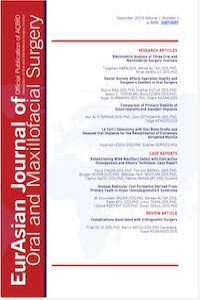Angular Changes in Impacted Mandibular Third Molars in Young Adults
Angular Changes in Impacted Mandibular Third Molars in Young Adults
angle, eruption, impaction, panoramic radiograph, radiology,
___
- 1. Dachi, S.F. and F.V. Howell, A survey of 3, 874 routine fullmonth radiographs. II. A study of impacted teeth. Oral Surg Oral Med Oral Pathol, 1961. 14: p. 1165-9.
- 2. Bishara, S.E. and G. Andreasen, Third molars: a review. Am J Orthod, 1983. 83(2): p. 131-7.
- 3. Grover, P.S. and L. Lorton, The incidence of unerupted permanent teeth and related clinical cases. Oral Surg Oral Med Oral Pathol, 1985. 59(4): p. 420-5.
- 4. Shepherd, J.P., The third molar epidemic. Br Dent J, 1993. 174(3): p. 85.
- 5. Silling, G., Development and eruption of the mandibular third molar and its response to orthodontic therapy. Angle Orthod, 1973. 43(3): p. 271-8.
- 6. Ricketts, R.M., A principle of arcial growth of the mandible. Angle Orthod, 1972. 42(4): p. 368-86.
- 7. Shepherd, J.P. and M. Brickley, Surgical removal of third molars. BMJ, 1994. 309(6955): p. 620-1.
- 8. Dodson, T.B., et al., Summary of the proceeding of the Third Molar Multidisciplinary Conference. J Oral Maxillofac Surg, 2012. 70(9 Suppl 1): p. S66-9.
- 9. Kruger, E., W.M. Thomson, and P. Konthasinghe, Third molar outcomes from age 18 to 26: findings from a population-based New Zealand longitudinal study. Oral Surg Oral Med Oral Pathol Oral Radiol Endod, 2001. 92(2): p. 150-5.
- 10. Spencer, A.J., et al., Service-mix of oral and maxillofacial surgeons in Australia and New Zealand. Int J Oral Maxillofac Surg, 1993. 22(5): p. 310-3.
- 11. Kandasamy, S., D.J. Rinchuse, and D.J. Rinchuse, The wisdom behind third molar extractions. Aust Dent J, 2009. 54(4): p. 284-92.
- 12. Mettes, T.D., et al., Surgical removal versus retention for the management of asymptomatic impacted wisdom teeth. Cochrane Database Syst Rev, 2012. 6: p. CD003879.
- 13. Haug, R.H., et al., The American Association of Oral and Maxillofacial Surgeons Age-Related Third Molar Study. J Oral Maxillofac Surg, 2005. 63(8): p. 1106-14.
- 14. Baqain, Z.H., et al., Frequency estimates and risk factors for postoperative morbidity after third molar removal: a prospective cohort study. J Oral Maxillofac Surg, 2008. 66(11): p. 2276-83.
- 15. Bui, C.H., E.B. Seldin, and T.B. Dodson, Types, frequencies, and risk factors for complications after third molar extraction. J Oral Maxillofac Surg, 2003. 61(12): p. 1379-89.
- 16. Chuang, S.K., et al., Age as a risk factor for third molar surgery complications. Journal of Oral and Maxillofacial Surgery, 2007. 65(9): p. 1685-1692.
- 17. Peterson, L.J., Rationale for removing impacted teeth: when to extract or not to extract. J Am Dent Assoc, 1992. 123(7): p. 198-204.
- 18. Alling, C.C., 3rd and G.A. Catone, Management of impacted teeth. J Oral Maxillofac Surg, 1993. 51(1 Suppl 1): p. 3-6.
- 19. Ades, A.G., et al., A long-term study of the relationship of third molars to changes in the mandibular dental arch. Am J Orthod Dentofacial Orthop, 1990. 97(4): p. 323-35.
- 20. Hasegawa, Y., et al., Influence of third molar space on angulation and dental arch crowding. Odontology, 2013. 101(1): p. 22-8.
- 21. Bayram, M., M. Ozer, and S. Arici, Effects of first molar extraction on third molar angulation and eruption space. Oral Surg Oral Med Oral Pathol Oral Radiol Endod, 2009. 107(2): p. e14-20.
- 22. Staggers, J.A., N. Germane, and W.M. Fortson, A comparison of the effects of first premolar extractions on third molar angulation. Angle Orthod, 1992. 62(2): p. 135-8.
- 23. Saysel, M.Y., et al., The effects of first premolar extractions on third molar angulations. Angle Orthod, 2005. 75(5): p. 719-22.
- 24. Song, F., et al., Prophylactic removal of impacted third molars: an assessment of published reviews. Br Dent J, 1997. 182(9): p. 339-46.
- 25. Phillips, C. and R.P. White, How Predictable Is the Position of Third Molars Over Time? Journal of Oral and Maxillofacial Surgery, 2012. 70(9): p. S11-S14.
- 26. Kandasamy, S., Evaluation and management of asymptomatic third molars: Watchful monitoring is a lowrisk alternative to extraction. Am J Orthod Dentofacial Orthop, 2011. 140(1): p. 11-7.
- 27. von Wowern, N. and H.O. Nielsen, The fate of impacted lower third molars after the age of 20. A four-year clinical follow-up. Int J Oral Maxillofac Surg, 1989. 18(5): p. 277-80.
- Başlangıç: 2020
- Yayıncı: Ağız ve Çene Yüz Cerrahisi Birliği Derneği
Ömer EKİCİ, Mehmet Bilgehan PEKTAŞ
Angular Changes in Impacted Mandibular Third Molars in Young Adults
Göknur TOPALOĞLU YASAN, Hakan TUZ, Halil Tolga YÜKSEL, Kevser BÜLBÜL, Mine OĞUZCAN, Mina SHAHMARI
Maxillary Sinus Barotrauma with Infraorbital Nerve Paresthesia After Scuba Diving: A Case Report
Mehmet Zahit BAŞ, Semiha Seda ŞAHİN
Application of TMJ Prosthesis After Multicystic Ameloblastoma Resection: A Case Report
Ömer ERDUR, Muhammed Sefer AKKOÇ, Ahmet AKTI, Gökhan GÜRSES, Adil ERSOY
Le Fort I Osteotomisi Uygulanan Hastalarda Cinch Süturun Burun Yumuşak Dokusuna Etkisi
Giant Cell Angiofibroma: A Rare Tumour in the Oral Cavity
Issa Al AZRI, Ahmed Al HASHMI, Hunaina Al KINDI, Mina GEORGE, Kaouther BACCOUCHE
